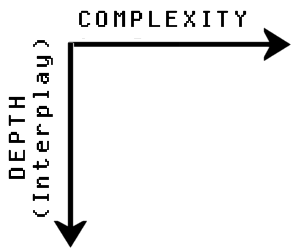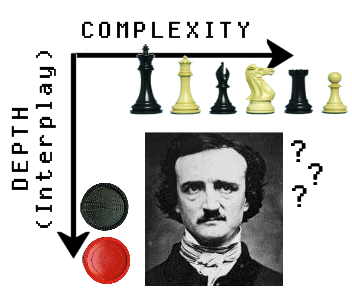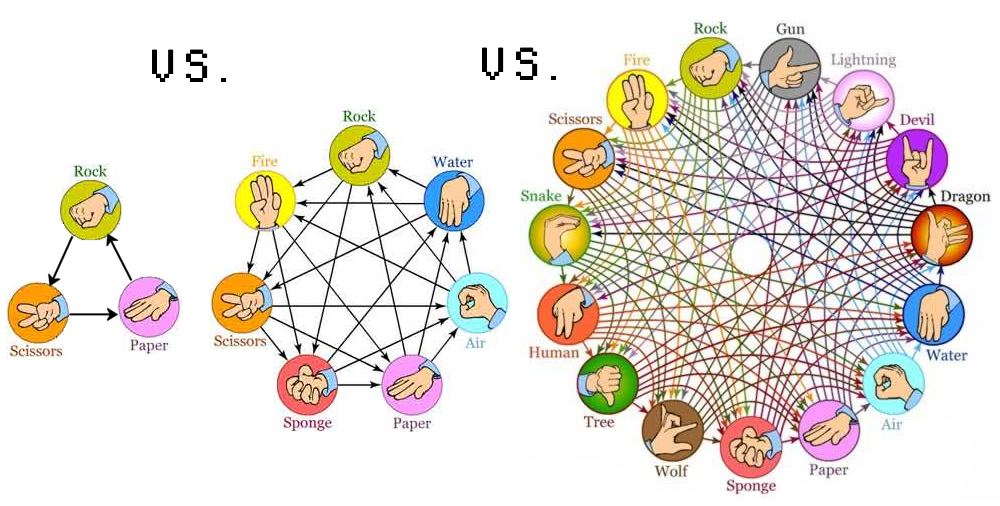Depth vs. Complexity
So now we've come to the point in the discussion where we must compare depth (interplay) and complexity. When you think about it, it makes complete sense that depth and complexity are orthogonal to each other. Depth comes from interactivity over time as a player explores a game's changing states and challenges. Complexities expand a single level/state of a game by presenting information that the player must consider or process before making an informed decision.

Edgar Allan Poe wrote this in the 2nd paragraph of "Murders in the Rue Morgue" which speaks to the relationship between depth and complexities. I've highlighted particularly pertinent lines in bold and added comments in (parenthesis for clarification).
"The faculty of re-solution is possibly much invigorated by mathematical study, and...has been called...analysis. Yet to calculate is not in itself to analyze. A chess-player, for example, does the one, without effort at the other. It follows that the game of chess, in its effects upon mental character, is greatly misunderstood. I am not now writing a treatise, but simply prefacing a some-what peculiar narrative by observations very much at random; I will, therefore, take occasion to assert that the higher powers of the reflective intellect are more decidedly and more usefully tasked by the unostentatious game of draughts (checkers) than by all the elaborate frivolity of chess. In this latter, where the pieces have different and bizarre motions, with various and variable values, what is only complex, is mistaken... for what is profound (deep). The attention is here called powerfully into play (gameplay/interactivity). If it flag for an instant, an oversight is committed, resulting in injury or defeat. The possible moves (range of information to be processed to make an informed decision) being not only manifold (various), but involute (complex), the chances of such oversights are multiplied; and in nine cases out of ten, it is the more concentrative rather than the more acute player who conquers (It's easy to overlook something and make a costly mistake). In draughts (checkers), on the contrary, where the moves are unique and have but little variation, the probabilities of inadvertence are diminished, and the mere attention being left comparatively unemployed, what advantages are obtained by either party are obtained by superior acumen (You gain advantages directly over/through the opponent player by interacting and not by studying)..."

According to Poe, or rather the speaker from the excerpt, when a player versus player game has a lot of complexities, the actual game is more likely to be decided by factors of personal concentration and stamina rather than cunning moves and counter moves. Keeping a game as simple as possible keeps the gameplay focused on making important decisions. This same idea can be applied to modern computer and video games. Even in games that pit the player versus a computer AI or game system, focusing on interplay rather than complexities helps put the responsibility in the player's hands. In a relatively simple game like Super Mario Brothers, it's easy for even beginning players to understand how they lost and that it was completely their fault. This small amount of accountability on the player's part goes a long way in teaching by building confidence and strategies needed to do better the next time.
Depth & Complexity
At this point in the article, it may seem like I'm against complexities in video games. Though I'm a staunch supporter of the concepts of intuitiveness, pick up and play, interplay, simplicity, clean design, and form fits function, I also understand that complexity is something that's an inevitable part of variation. Every level element, enemy element, or powerup that has a unique function must be learned by the player. Such unique variations inherently add a degree of complexity to a game.
Every game can't be another version of Paper Rock Scissors, an efficient game system that has perfectly balanced interplay with as few gameplay elements as possible. Video games are so varied that there's plenty of room for games like RPS, Professor Layton (little to no interplay and lots of complexities), and everything in between. For those who want to add more content/complexities to their games but want to also avoid the negative effects, it's important to design each piece of content to take up a unique design space according to the core dynamics of the game system. It wouldn't make much sense to design a new pink Goomba that walked around slightly slower than a normal Goomba. The core dynamic of Super Mario Brothers is gravity, not the timing of enemy movement.

In Super Mario Brothers, each enemy takes up a unique design space in how they move (contrary motion) and/or their interplay. Jonathan Blow talked on how there are only 3 enemies in Braid. Because each takes up a unique design space he found that he didn't need to design any other enemies. The plant is an enemy with respect to time, the "Goomba" is an enemy that moves in a simple way through space, and the rabbit is a more complex "Goomba" in that it seeks out the player and has an agro range. Because each enemy type takes up a unique design space, they can layer together better to influence the player in different ways in a level. When a game element is designed to take up a unique design space, their individual function within the game becomes more distinct, which makes that element more memorable and less likely to be simplified/optimized/or reduced.

The best example of a game with complexities that aren't designed to take up unique design spaces are the expanded RPS projects. As I've said earlier, RPG is a perfectly balanced game designed with a closed loop of interplay that's as efficient as possible. Adding more moves to this game brings up two issues. The additional moves would either be unbalanced (some moves having a disproportionate number of ways to win or lose than other moves), or the additional moves would be balanced like the original game at the expense of making the game more complicated. In each of the extended RPG games, the additional moves don't make the game any deeper. They just make it more complex. See for yourself by playing this digital version of RPS featuring the classic 3 move RPS and versions that extend the game up to 25 moves. Be sure to check out this version of RPS that features 101 different moves. Here's what the creator had to say about his game.
A game so complex, I highly doubt anyone will actually even want to attempt to play it. It's not just remembering what beats what, but remembering how to actually say all 5,050 outcomes is something only a savant could manage.

As detailed on his blog, when Daivid Sirlin set out to create the online card game known as Kongai, he adapted the basic design of the Pokemon GBA/DS battle system by focusing on the core interplay/interactions. By removing all of the complexities from the Pokemon battle system, Sirlin was left with a system that's based around double blind actions (when both players give commands/do moves at the same time like in RPS), and a simple weakness/resistance system that easily fosters mind games. Gone are the 17x17 charts of Pokemon types, gone are the pages and pages of different attacks each Pokemon can have, and gone are the complicated mathematical equations that are processed behind the scenes. What's left is a more focused, cleaner, and a less complicated game.
Aside from designing gameplay elements to take up unique design spaces, there are other measures that help create a balance between depth and complexity.
- Form Fits Function: The more a player can deduce how a given mechanic functions within the game world by how it looks, the easier the learning process with be. Such a design is like building the notes into the test. It's like a functional cheat sheet.
- Using little to no abstract counters or special case counters: Learning the ins and outs of these counters is simply a matter of memorization. This can be especially troublesome when the game teaches the player through repeated example that things go one way, but this one example goes the other way. Such a small break in the established order/trend can create a large negative effect on the learning process. It's as if 3/100 times when you answer yes, it comes out no. 97/100 times, you'll get used to the answer that you say being the answer that is communicated. But every once in a while (3/100 times) the confidence you built up in your answers will be damaged.
- Using mostly natural counters (for games with space), then cause and effect, then decay counters: These counters are typically designed with obvious forms and/or logical consequences. If it looks like our character avoids a laser beam, then we expect not to take damage from it. When we shoot a gun in an FPS, we assume that there are a limited amount of shots we can take before reloading. If we explode a barrel and fire spreads everywhere, we assume that touching the fire will cause us damage. By adhering to natural, cause and effect, and decay counters, the game world becomes more interactive and complex without offsetting the balance between learning and playing.
In part 4, we'll look at some special types of interplay systems and the types of interplay at work in actual high level game strategies.